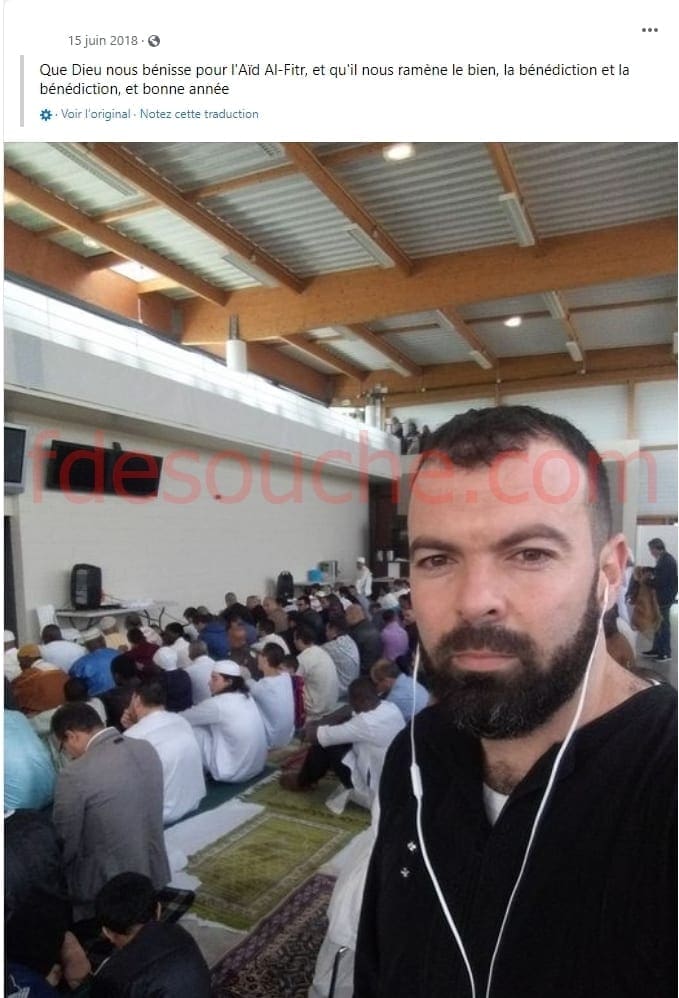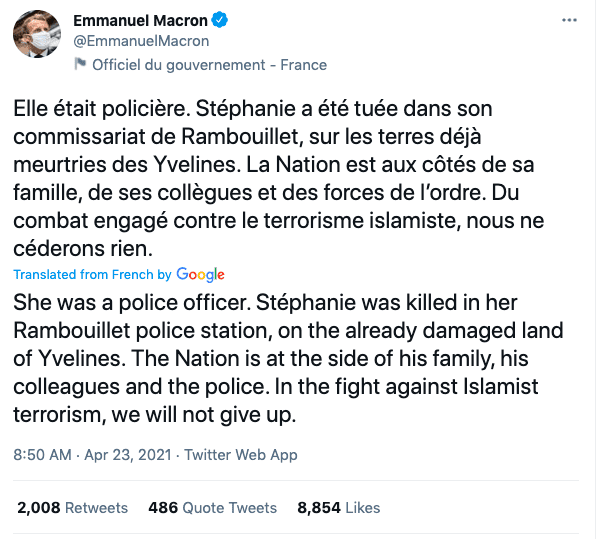Due to mass illegal migration, France is now the most densely Muslim populated country in Europe, where terror attacks are now the norm.
A French policewoman was stabbed to death in the neck at a train station southwest of Paris by 36-year-old Djamel G, a Muslim migrant from Tunisia. Security forces shot the Muslim who shouted “Allah Akbar” while slaughtering the woman.
The attack took place in the entrance area of the station at around 2:20 pm (1220 GMT). The 49-year-old woman, Stéphanie, an administrative assistant and mother of two returning from a lunch break, was stabbed in the throat twice and died of her wounds shortly afterward.
The terrorist from Tunisia came to France illegally in 2009 but obtained residency in 2019. According to police, he was unknown to security services. He had just moved to Rambouillet and had previously worked as a delivery driver. He had a Temporary Residence Card valid until December 25, 2021.
Three days after teacher Samuel Paty’s was beheaded he posted this photo:




France’s national anti-terrorism prosecutors said they had opened a terror investigation involving the DGSI domestic intelligence service into the murder of a person holding public authority.
France, open borders President Emmanuel Macron vowed on Twitter that “in our fight against Islamist terrorism, we will never give in,” identifying the murdered victim as Stéphanie.
“The nation is by the side of her family, her colleagues and security forces,” he said.

The public’s frustration with Macron remains high: 60% of the French say they are dissatisfied or very dissatisfied with how he is managing the country.
Islamic attacks in France
Islamic attacks across France are unfortunately the norm in a country struggling with mass illegal migration. France is the main Islamic country in Europe, with 8.8% of its population now being Muslim. According to Gatestone, Islam is the second largest religion in France but comes in first if one counts the number of active practitioners.
In September, a Pakistani man wounded two people with a meat cleaver outside the former offices of satirical magazine Charlie Hebdo, which had printed cartoons of Mohammed.
On October 16, 2020, a young Chechen refugee-beheaded French schoolteacher Samuel Paty was beheaded after showing students a cartoon by Hebdo during a class discussion about the Islamic attack.
And on October 29, 2020, three people were killed when a recently arrived Tunisian went on a stabbing spree in a church in Nice. One elderly victim was “virtually beheaded,” officials said.
In the most severe recent attack against French police, three officers and one police employee in Paris were stabbed to death in October 2019 by a Muslim IT specialist colleague who was then shot dead.
These Islamic attacks came after the massacres carried out by Muslims from 2015 that began with the massacre of staff in the offices of the French Satirical magazine on January 7th that year.
On November 2015, 130 people were killed and 350 were wounded when Muslim suicide bombers and gunmen attacked the Stade de France stadium, bars and restaurants in central Paris and the Bataclan concert hall.
The next year a man rammed a truck into a Bastille Day crowd in Nice in 2016, killing 86 people.
Just a few weeks before, in June 2016, two police officers were stabbed to death at their home outside Paris by a man claiming allegiance to the Islamic State group.
France Has Been Silenced
After the 2015 Charlie Hebdo Muslim terrorist attacks rocked France, any writings or words critical of Islam make anyone a target for assassination attempts and intimidation campaigns. Fearing for their lives, most respond with self-censorship and submission to Islam, those who chose to speak out suffer grave consequences.
Hebdo magazine survivors remain under police protection. From Laurent Sourisseau, the publishing director and majority owner of Charlie, to survivor Zineb el Rhazoui, a French-Tunisian intellectual and journalist. Philippe Val, the former director of Charlie Hebdo, who decided to publish the Mohammed cartoons in 2006, also remains under police protection.
French teachers, politicians, LGBT activists, cartoonists, clergy, movie stars, academics, intellectuals, novelists, writers, journalists, among others, have been threatened and/or targeted for death because they dare to say something that upsets a Muslim.
As previously reported at RAIR Foundation USA, since February 2021, Didier Lemaire, a teacher for twenty years in France, must live under 24-hour police protection. Also, he must leave his profession after his life was threatened for honoring the memory of the beheaded history teacher, Samuel Paty, and defending the Republic’s values. Instead of denouncing the threats of violence against the philosophy teacher, Ali Rabeh, the Muslim mayor of Trappes, further incited those threatening his life.
In March 2020, two University Professors at the Grenoble Institute of Political Studies (IEP) in eastern France had to be placed under 24-hour police protection after being smeared as “Islamophobes” and “fascists.” The teachers’ lives are under threat after an Islamo-leftist student group, the National Union of Students of France (UNEF), led a dangerous campaign against the professors for simply trying to question the concept of “Islamophobia.”
Since January 2020, a French gay teen girl, ‘Mila,’ has been threatened with murder, rape, and torture by Muslims for several years after criticizing Islam. Mila has had to live under 24-hour police protection. According to her lawyer, she receives about 30 hate messages a minute.
French philosopher and journalist Eric Zemmour lives under police protection since the attack on Charlie Hebdo. “Two policemen follow him wherever he goes — including to court, where Muslim organizations tried to defame him and his work by accusing him of “Islamophobia” to silence him,” reported Gatestone.
Also, Michel Houellebecq, author of the novel “Submission,” has lived under the police’s protection since he published his last novel in 2015. Along with, Frédéric Haziza, a radio journalist and author for the magazine Le Canard Enchaîné.
According to Gatestone, Mohammed Sifaoui, who lived undercover in a French cell of al Qaeda and wrote the book, Combattre le terrorisme islamiste (“Combat Islamist Terrorism”), lives under police protection. His photo and name appear on jihadi websites next to the word murtad (“apostate”).
Muslims did not just succeed in physically silencing Charlie Hebdo’s journalists in 2015; they have successfully imposed sharia and silenced an entire national culture.
Three days after teacher Samuel Paty’s was beheaded he posted this photo:




France’s national anti-terrorism prosecutors said they had opened a terror investigation involving the DGSI domestic intelligence service into the murder of a person holding public authority.
France, open borders President Emmanuel Macron vowed on Twitter that “in our fight against Islamist terrorism, we will never give in,” identifying the murdered victim as Stéphanie.
“The nation is by the side of her family, her colleagues and security forces,” he said.

The public’s frustration with Macron remains high: 60% of the French say they are dissatisfied or very dissatisfied with how he is managing the country.
Islamic attacks in France
Islamic attacks across France are unfortunately the norm in a country struggling with mass illegal migration. France is the main Islamic country in Europe, with 8.8% of its population now being Muslim. According to Gatestone, Islam is the second largest religion in France but comes in first if one counts the number of active practitioners.
In September, a Pakistani man wounded two people with a meat cleaver outside the former offices of satirical magazine Charlie Hebdo, which had printed cartoons of Mohammed.
On October 16, 2020, a young Chechen refugee-beheaded French schoolteacher Samuel Paty was beheaded after showing students a cartoon by Hebdo during a class discussion about the Islamic attack.
And on October 29, 2020, three people were killed when a recently arrived Tunisian went on a stabbing spree in a church in Nice. One elderly victim was “virtually beheaded,” officials said.
In the most severe recent attack against French police, three officers and one police employee in Paris were stabbed to death in October 2019 by a Muslim IT specialist colleague who was then shot dead.
These Islamic attacks came after the massacres carried out by Muslims from 2015 that began with the massacre of staff in the offices of the French Satirical magazine on January 7th that year.
On November 2015, 130 people were killed and 350 were wounded when Muslim suicide bombers and gunmen attacked the Stade de France stadium, bars and restaurants in central Paris and the Bataclan concert hall.
The next year a man rammed a truck into a Bastille Day crowd in Nice in 2016, killing 86 people.
Just a few weeks before, in June 2016, two police officers were stabbed to death at their home outside Paris by a man claiming allegiance to the Islamic State group.
France Has Been Silenced
After the 2015 Charlie Hebdo Muslim terrorist attacks rocked France, any writings or words critical of Islam make anyone a target for assassination attempts and intimidation campaigns. Fearing for their lives, most respond with self-censorship and submission to Islam, those who chose to speak out suffer grave consequences.
Hebdo magazine survivors remain under police protection. From Laurent Sourisseau, the publishing director and majority owner of Charlie, to survivor Zineb el Rhazoui, a French-Tunisian intellectual and journalist. Philippe Val, the former director of Charlie Hebdo, who decided to publish the Mohammed cartoons in 2006, also remains under police protection.
French teachers, politicians, LGBT activists, cartoonists, clergy, movie stars, academics, intellectuals, novelists, writers, journalists, among others, have been threatened and/or targeted for death because they dare to say something that upsets a Muslim.
As previously reported at RAIR Foundation USA, since February 2021, Didier Lemaire, a teacher for twenty years in France, must live under 24-hour police protection. Also, he must leave his profession after his life was threatened for honoring the memory of the beheaded history teacher, Samuel Paty, and defending the Republic’s values. Instead of denouncing the threats of violence against the philosophy teacher, Ali Rabeh, the Muslim mayor of Trappes, further incited those threatening his life.
In March 2020, two University Professors at the Grenoble Institute of Political Studies (IEP) in eastern France had to be placed under 24-hour police protection after being smeared as “Islamophobes” and “fascists.” The teachers’ lives are under threat after an Islamo-leftist student group, the National Union of Students of France (UNEF), led a dangerous campaign against the professors for simply trying to question the concept of “Islamophobia.”
Since January 2020, a French gay teen girl, ‘Mila,’ has been threatened with murder, rape, and torture by Muslims for several years after criticizing Islam. Mila has had to live under 24-hour police protection. According to her lawyer, she receives about 30 hate messages a minute.
French philosopher and journalist Eric Zemmour lives under police protection since the attack on Charlie Hebdo. “Two policemen follow him wherever he goes — including to court, where Muslim organizations tried to defame him and his work by accusing him of “Islamophobia” to silence him,” reported Gatestone.
Also, Michel Houellebecq, author of the novel “Submission,” has lived under the police’s protection since he published his last novel in 2015. Along with, Frédéric Haziza, a radio journalist and author for the magazine Le Canard Enchaîné.
According to Gatestone, Mohammed Sifaoui, who lived undercover in a French cell of al Qaeda and wrote the book, Combattre le terrorisme islamiste (“Combat Islamist Terrorism”), lives under police protection. His photo and name appear on jihadi websites next to the word murtad (“apostate”).
Muslims did not just succeed in physically silencing Charlie Hebdo’s journalists in 2015; they have successfully imposed sharia and silenced an entire national culture.

